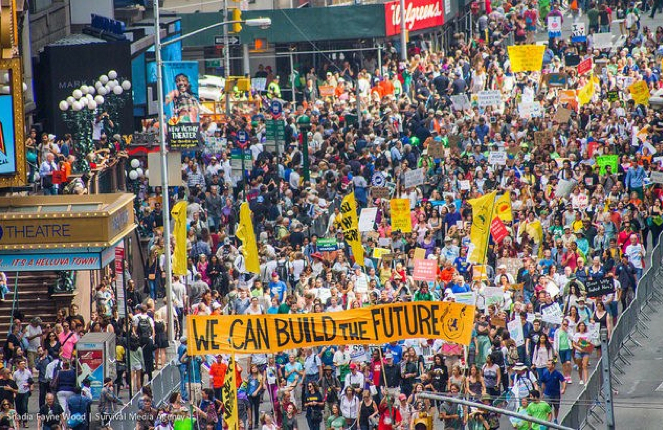
More than 310,000 people march to send world leaders a message that it’s past time to take action on climate change. Is there an opportunity to make this an election issue? This week the United Nations begins a summit of world leaders to propose a “framework” for solutions. Photo by Shadia Fayne Wood / Survival Media Agency via People Climate March NYC. (Creative Commons)
The People’s Climate March in New York City Sunday was supposed to be huge. There were some 1,500 organizations as sponsors, including several indigenous groups from around the world, expecting more than 100,000 people. But they were wrong because more than 310,000 people showed and feeds on Twitter, Facebook and Instagram were jammed with reports of family and friends marching and demanding environmental justice. The New York event even started with a request for permission to protest on occupied Native land. And if the New York City protest wasn’t enough, there were similar events across the globe. As Bill McKibben, co-founder of 350.org, said Sunday, “You know what, this is the most important place in the world right now.” So if people understand the implications of global warming and climate change, do politicians? “Time is not on our side,” said World Meteorological Organization Secretary-General Michel Jarraud in a news release. “If we don’t act on climate change, it means we are living at the expense of what we leave to our children. It’s like borrowing money and leaving a huge debt to our children.” (The WMO has an interesting “weather” report from the future, explaining some of the climate projections in an easy to understand newscast.) Though averting that scenario is still possible, “It will require bold decisions, courageous decisions,” he said. Some of that process will unfold at the United Nations this week. But those who argue against action are also pulling levers, both in New York and in Washington, D.C. That’s why I think global warming should be at the top of any voter’s must list this November. The World Meteorological Organization released a report that shows the “amount of greenhouse gases in the atmosphere reached a new record high in 2013, propelled by a surge in levels of carbon dioxide.” “The Greenhouse Gas Bulletin shows that, far from falling, the concentration of carbon dioxide in the atmosphere actually increased last year at the fastest rate for nearly 30 years. We must reverse this trend by cutting emissions of CO2 and other greenhouse gases across the board,” Jarraud said. “We are running out of time.” Let’s put this into a political context. In elections from Alaska to South Dakota global warming might as well be on the ballot. (A recent survey says only 25 percent of Republicans see climate change as a major threat.) Alaska’s Republican candidate for the U.S. Senate told Sitka’s KCAW radio that “I think the jury’s out on climate change.” And in South Dakota, former Gov. Mike Rounds, running for the Senate, doesn't talk much about global warming. Instead he recently posted on Facebook: “Five years of inaction for Keystone XL pipeline is far too long. Build it now for America's energy independence!” Build it now? Add to the carbon dioxide problem we already have? I would go further. We should rule out any candidate for any office that denies the science of global warming. It’s fair for politicians to quibble with a study, or even a few, but let’s be clear here, nearly all climate scientists are saying the same thing. They’re sounding an alarm. Here are key figures from The National Aeronautics and Space Administration. “Ninety-seven percent of climate scientists agree that climate-warming trends over the past century are very likely due to human activities,and most of the leading scientific organizations worldwide have issued public statements endorsing this position.” The facts are that carbon dioxide (CO2) measurements from the Mauna Loa Observatory, Hawaii, show that CO2 concentration in our atmosphere has increased by about 24 percent since 1958. And that is the primary driver of global climate change. NASA scientists say 2013 tied with 2009 and 2006 for the seventh warmest year since 1880, continuing a long-term trend of rising global temperatures. What will it take for the political establishment to move forward on a climate change policy with the same urgency as starting another war in the Middle East? Hundreds of thousands of people on the streets of New York might only be the start. There is no more important reason to vote in November 2014. Mark Trahant holds the Atwood Chair at the University of Alaska Anchorage. He is an independent journalist and a member of The Shoshone-Bannock Tribes. For up-to-the-minute posts, download the free Trahant Reports app for your smart phone or tablet.
Join the Conversation
